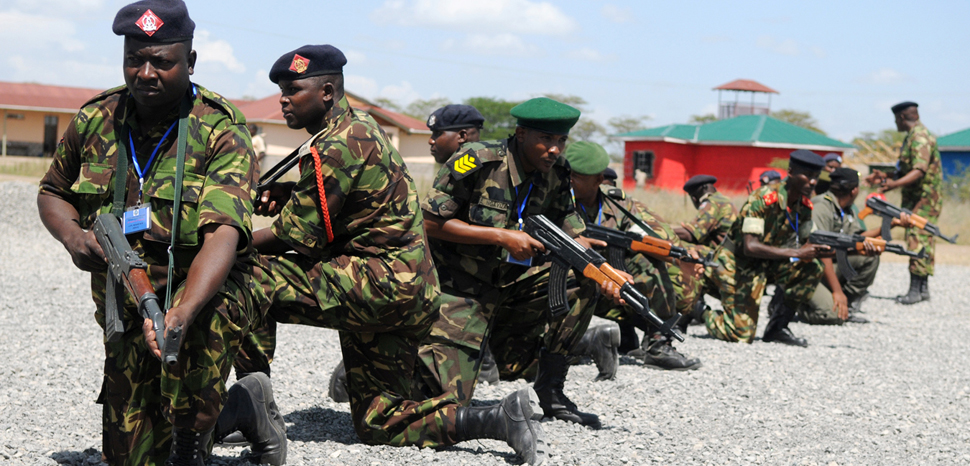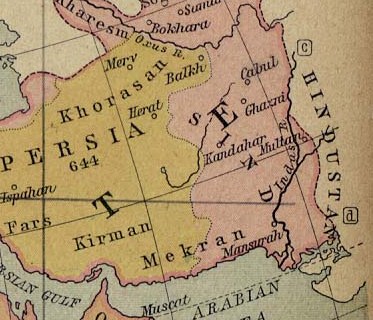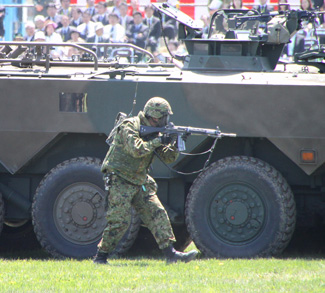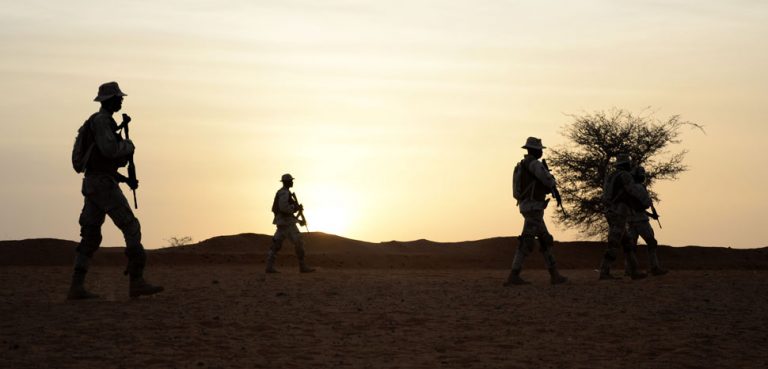The 1980 film The Dogs of War offers a highly realistic depiction of a team of mercenaries (led by none other than Christopher Walken) overthrowing the brutal dictator of the fictional African nation of Zangaro. The film, and the book from which it was adapted, is itself based on author Frederick Forsyth’s own experiences in Africa during the Nigerian Civil War, in which foreign mercenaries played a central role. Almost fifty years since that conflict, and forty since the film, not much has changed in Africa – at least in terms of instability and the suffering that comes with it. In fact, it has probably gotten worse. But today’s threats are far more dangerous to both the continent and the greater global order beyond.
Today’s Africa is home to some of the world’s most violent warzones. Nowhere does chaos currently reign more supreme, particularly as the main refuse point for the blowback out of Western wars in the Middle East. With the collapse of Islamic State strongholds in Iraq and Syria, thousands of al-Qaeda and ISIS fighters have flooded into the continent to link up with jihadist groups and foment conflict across its vast expanse.
Many experts now simply define al-Qaeda and ISIS as nothing more than glorified criminal cartels – but far more dangerous. The DEA reports that jihadists have turned Libya into a major transit hub for both narcotics and human traffic entering the European market, forging ties with major crime syndicates in Italy, the Balkans, Ukraine, and Russia. Approximately 40% of the cocaine reaching Europe each year transits through jihadist turf in Mali, Niger, the Sahara and Libya. ISIS and al-Qaeda made well over $300 million in a single year alone from human-trafficking. Since their expansion into Africa, rhino poaching alone has shot up by over 7000%. A single rhino horn can fetch $300,000 USD on the black market – enough to arm, feed, and train 75 ISIS fighters for an entire year. And in the chaos of post-Gaddafi Libya, several thousand shoulder-launched surface-to-air missiles, each worth up to $15,000 USD on the black market and able to bring down a commercial airliner, still remain unaccounted for. No one is searching for them.
The United States has committed an entire military command, AFRICOM, to the region, and deployed large numbers of special operations forces and drones to engage the terrorists head-on. In terms of tactical aggression and operational tempo, they are right where they should be. However, defeating today’s terrorists – particularly in Africa – will require a far more dexterous approach than the standard counterinsurgency doctrine might prescribe. One that can apply special operations skill sets to tactically counter the paramilitary threat of the modern jihadists, while simultaneously addressing greater strategic issues.
In The Dogs of War, Simon Endean, the man who hires Walken’s team of mercs, asks: Could a small mercenary force overthrow the main target of the coup, a psychopathic dictator called Kimba? Endean is asking for a surgical approach. He doesn’t simply wish to remove the head of the snake. He wants to remove a tumor from the head of that snake and gain control of the snake itself. Walken and his crew are to be the scalpel. Well—spoiler alert—although Walken, playing the angrily reluctant hero, throws Endean out of his dreary New York bolt-hole where he keeps a pistol in the fridge, the answer is simply: Yes. And they do. With maximum caution and extreme prejudice.
Now, in today’s world, it isn’t necessarily a dictator that needs overthrowing. In fact, we’ve overthrown a couple in the last fifteen years, albeit using hammers rather than scalpels, one of which was in Libya, and – well, as Dr. Phil might ask in a moment like this with his Texas twang: “How’s that workin for ya?”
But the question remains: Could a small mercenary force, our own scalpel, or perhaps – since it is the 21st century, after all – a surgical laser, cut out a tumor that is fast-metastasizing across Africa?
And if so, how?
How do you take down a paramilitary terrorist organization whose various groups collectively comprise a vast criminal conspiracy as well as a geopolitical threat that rivals even powerful state actors?
By recognizing what feeds that beast.
Not terror itself, which is retail, but the crime that funds it.
Terrorists engaging in criminal activity is nothing new. Hezbollah, Iran’s main terrorist proxy, smuggles cigarettes into Canada, moves stolen cars out of the U.S., and runs Lebanese blonde hashish and high-grade smack out of their own backyard in the Bekaa Valley. For over two decades, the Taliban have supplied most of the heroin that Europeans shoot into their veins.
But it is al-Qaeda and ISIS who rely on crime more than any other group to fund their terrorist operations, building a criminal empire on par with that of the Mexican drug cartels, Russian mob, or Italian mafia. For both terror groups, crime is merely a means to an end – that end being the establishment of a global caliphate under the black banner of Salafist Islam – which can only be achieved through war. Indeed, in its own online propaganda publication, Rumiyah, ISIS has stated that conflict zones such as Syria and Ukraine offer the perfect opportunity to forge ties with the criminal underworld.
While both groups maintain a significant network of private donors across the Muslim world, particularly in Saudi Arabia and the Gulf States, crime has proven a far more consistently lucrative source of funding – with human-trafficking, drug-smuggling, gun-running, and animal-poaching being the four top-earners, especially in their latest favorite playground – Africa.
ISIS seems to have a natural proclivity for crime. The group encourages its Western recruits to engage in street-level crime to raise small-scale operational and logistical funds – drug-dealing, theft, credit card fraud – anything that might pay for a plane ticket to Iraq, Syria, or now, more so, Africa. And ISIS not only encourages drug-dealing, but drug-use as well. ISIS fighters in Iraq, Syria, Libya and Nigeria are known to take so-called “jihad pills,” mainly Captagon and tramadol, to stay amped up on the battlefield, as they engage in ferocious combat with their sworn enemies, a habit they may have inherited from the fierce Chechen fighters who initially trained them, and were also known to get jacked on amphetamine-type stimulants to better take Western bullets and stay combat-capable.
Qaeda itself, having further fractured and decentralized into a franchise-like structure of affiliates, has engaged more aggressively in large-scale criminal enterprise, nowhere more so than in the Sahel region of Africa, where whole swathes of ungoverned space and lawless lands offer plenty of opportunity for illicit gain. Mokhtar Belmokhtar, a former top commander of al-Qaeda in the Islamic Maghreb (AQIM), believed killed in Libya, was, according to French criminologist Alain Bauer, “a classic case in point of hybrid terror-criminality.” According to Bauer, Belmokhtar was “…99-percent criminal and 1-percent jihadi.”
His one-time brother-in-arms, Adnan al-Sahrawi, now leader of AQIM’s main regional rival, the Islamic State in the Greater Sahara (ISGS) – which announced its existence with the October 2017 killing of four American special operations soldiers in Niger – is considered a major drug kingpin whose followers actually boast of his criminal prowess. Sahrawi has diversified big-time into human-trafficking, moving unwitting African migrants through Mali into Niger, and then on to Libya, where they are at the mercy of their smugglers, who often auction off the women and children into sex slavery alongside Yazidis out of Iraq. The rest are packed into rickety old boats for the perilous voyage across the Med – sometimes with ISIS infiltrators among them. According to the Guardian, Interpol has identified 50 foreign fighters who have come into Italy from Libya disguised as migrants to launch new attacks across Europe.
The real migrants pay $300-$400 USD per head for the journey. They also pay in other ways, with ISIS using them as pack mules, forcing them to transport South American cocaine along the same route into Libya, where it is then shipped into Italy via the notorious Port of Gioia Tauro, run by the dreaded ‘Ndrangheta. According to Italy’s anti-drug-trafficking agency, the DCSA, 80 percent of the cocaine consumed in Europe comes through this port. That’s 48 tons of cocaine worth approximately $1.8 billion every year. No surprise then, considering its links to terrorism, that Gioia Tauro also happens to be a main transshipment point for illegal weapons – most of them also out of Libya. The RAND Corporation believes that ISIS shot callers there have developed a strong business relationship with both the ‘Ndrangheta and the Neopolitan Camorra.
With a monopoly on the key smuggling routes through the Sahel, both AQIM and ISGS maintain direct ties to representatives of the Colombian drug cartels stationed in the thoroughly corrupt state of Guinea-Bissau, where they have been welcomed with both open arms and wallets. It is this relationship between narco and jihadist that offers the perfect example of the hybridization between the criminal underworld and terrorism. And also the vicious cycle between their four main sources of funding. From Guinea-Bissau, AQIM and ISGS transport South American cocaine through West Africa and then up through the Sahel – from Senegal to Mali to Niger, then Niger to Libya. For this, they receive 50-percent of the profits – a hefty sum. Hefty enough that in 2013, AQIM was able to use that cash to purchase AKs, surface-to-air missiles, and armored personnel carriers from soldiers fleeing Libya after the collapse of the Gaddafi regime. The jihadists used the weapons – some of which had been supplied by NATO countries after Gaddafi renounced his WMD program – to prosecute their insurgency in Mali, nearly overrunning the capital, Bamako, before France deployed over 4,000 troops to stop them. The group lost most of its gains in terms of occupied territory, but it was a close-run thing.
The trade in illegal wildlife, particularly rhino horns, is lucrative enough that the Islamic State has actively targeted counter-poaching forces for death. In one case, police arrested a group of poachers in South Africa who had a shoulder-fired missile in their possession that authorities later traced to a U.S. military stockpile that had fallen into ISIS’s hands after they took over Mosul. Intelligence officials believe that they sent the weapon to South Africa to shoot down a helicopter being used by a group called Rhino 911 to interdict their rhino-poaching efforts.
Apart from the monetary gains, both Qaeda and ISIS – like the Taliban and Hezbollah – understand the greater political benefits of profiting off of their enemy’s misery and degradation. The Taliban for decades has made a fortune as Europe’s number one supplier of heroin – using the revenue to fund their insurgency in Afghanistan, while creating addicts, fomenting crime, and undermining whole communities in the West. ISIS has adopted a similar model, issuing a fatwa allowing affiliates like ISGS to poison non-believers en masse.
ISIS has used the sex slave trade as part of its ethnic cleansing program to devastate the Yazidi people of Iraq, smuggling Yazidi women and girls into Libya to be auctioned off there or smuggled into Europe as sex slaves. ISIS uses the promise of sex slaves, many of them Yazidi, to entice young men from across the globe to join the fight in Iraq and Syria. The brutal Boko Haram, ISIS’s affiliate in Nigeria, has kidnapped thousands of girls, using them as cooks, sex slaves, and even suicide bombers. Like ISIS in Iraq and Syria, Boko Haram also uses the promise of sex slaves as a recruitment tool, and maintains “rape camps” where they purposely impregnate their victims to produce “the next generation of fighters.” Sexual slavery is not only a means of profit for jihadists, but one of their most potent weapons against local populations.
ISIS and Qaeda may be on the run in Syria and Iraq, but they are still metastasizing in Africa and still trading in guns, drugs, animal parts, and innocent human beings that finance their cause. Bauer argues that recognizing the hybrid nature of the threat – between terrorist and criminal, and the funding sources – is the key to crushing it.
This is where our own team of mercs can come in, or multiple teams of them. Not just war-fighters alone, but elite teams of former U.S. and foreign intelligence and law enforcement officers, military veterans, and special operators. People with African experience who can work more flexibly than official military forces with indigenous elements to identify and cutoff the key choke points – not only fighting on the frontlines to take down the terrorists on their own turf, but connecting the dots to unmask the shadowy networks that deal in the drugs, guns, poaching and human traffic that finance their activities. The mission: to cut the terrorists off at the ankles by cutting off their main sources of funding.
Just as we have witnessed a hybridization of crime and terror in modern jihadism, so, too, must we counter this threat with a hybridization of our own forces – an all-star “Justice League-like” force of former crime-fighters and counter-terrorists who can engage this vicious enemy both tactically and strategically. Who can go from taking down a drug or slave-trade transit point with force, to employing criminal-forensic investigative techniques, or engaging in proactive human-intelligence-gathering and psychological operations, to coordinating further takedowns on a much wider scale. And, as mercenaries, who will not be bound by the restrictive politics, bureaucracy, and internecine rivalries that all too often undermine real-time adaptability, and blunt the surgical instruments meant to cut out the worst kind of cancers.
The opinions, beliefs, and viewpoints expressed by the authors are theirs alone and don’t reflect the official position of Geopoliticalmonitor.com or any other institution.




